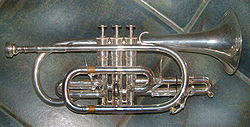
Cornet
Background to the schools Wikipedia
SOS Children has tried to make Wikipedia content more accessible by this schools selection. SOS Children works in 45 African countries; can you help a child in Africa?
The cornet is a brass instrument very similar to the trumpet, distinguished by its conical bore, compact shape, and mellower tone quality. The most common cornet is a transposing instrument in B♭. It is not related to the medieval cornett or cornetto.
The cornet was originally derived from the post horn. Sometimes it is called a cornopean, which refers to the earliest cornets with the Stölzel valve system.
This instrument could not have been developed without the invention of the valves by Stölzel and Blühml. These two instrument makers almost simultaneously invented the modern valves, as still used today. They jointly applied for a patent and were granted this for a period of ten years. The first great player was Jean Baptiste Arban. In the first half of the 19th century he studied cornet at the Conservatoire National in Paris. He started studying the cornopean but quickly changed to the cornet. He was influenced by Niccolò Paganini, the violin virtuoso, and tried to apply his technical virtuosity to brass instruments. The cornet proved to be the perfect vehicle for this. For the next 100 years the trumpet and cornet coexisted in musical ensembles. In symphonic repertoire one will often find separate parts for both trumpet and cornet. As several instrument builders made improvements to both instruments, they started to look and sound more alike. The modern day cornet is used in brass bands, concert bands, wind ensembles, and in specific symphonic repertoire that requires a more mellow sound.
Ensembles with cornets
Brass band
Brass band ensembles consists completely of brass instruments (except for the percussion). The cornet is the leading melodic instrument in this ensemble and trumpets are never used. The ensemble consists of about thirty musicians, including nine B♭ cornets, one E♭ cornet (soprano cornet), and one flugelhorn. Brass bands have been most popular in Great Britain, Scandinavia and Northern Europe, but their popularity is increasing in the USA. Brass bands and brass ensembles are the only instrumental groups within the Salvation Army, where cornets are used exclusively. All of the brass instruments in brass bands read music written in treble clef, with the exception of the bass trombone which is written in bass clef.
A full line up for a Brass Band might be: 1 E flat Soprano Cornet, 4 Solo Cornets, 1 Repiano Cornet, 2 Second Cornets, 2 Third Cornets, 1 Flugel Horn, 3 Tenor Horns, 2 Baritones, 2 Euphoniums, 2 Tenor Trombones, 1 Bass Trombone, 2 E flat basses, 2 B flat basses, Percussion as required.
Concert Band
The cornet also features in the British-style concert band, unlike the American concert band/wind band, where it is replaced by the Trumpet. This slight difference in instrumentation derives from the British concert band's heritage in the Military band, where in Britain the highest brass instrument is always the cornet. There are usually four to six B♭ cornets present in a concert band, but no E♭ instrument, as this role is taken by the E♭ clarinet.
Fanfare Orkest (NL and B)
Fanfare Orkest orchestras are only found in the Netherlands, Belgium and Northern France. The leading melodic instruments are the Flugelhorn and the soprano saxophone but it uses both cornet and trumpet in its standard setup, also the E♭ soprano cornet is used. In the last decades the cornet has been largely replaced by the trumpet.
Jazz band
In old style jazz bands the cornet was preferred to the trumpet, but from the swing era onwards it has been largely replaced by the trumpet, although it has never passed completely out of use. The cornet is now rarely found in big bands mainly because of its limited volume and less piercing tone in comparison to the trumpet. A growing taste for louder and more aggressive sounding instruments has been the chief cause of this trend, especially since the advent of bebop in the post World War II era. Louis Armstrong, probably the most well-known jazz cornetist, started off on the cornet, but later switched primarily to trumpet. Other notable jazz cornetists include King Oliver, Bix Beiderbecke, Ruby Braff and Warren Vache.
Relationship to trumpet
The cornet was invented by adding valves to the post horn in 1814. The valves allowed for melodic playing throughout the register of the cornet. Trumpets were slower to adopt the new valve technology, so for the next 100 years or more, composers often wrote separate parts for trumpet and cornet. The trumpet would play fanfare-like passages, while the cornet played more melodic passages. The modern trumpet has valves that allow it to play the same notes and fingerings as the cornet.
Cornets and trumpets made in a given key (usually the key of B♭) play at the same pitch, and the technique for playing the instruments is nearly identical. However, cornets and trumpets are not entirely interchangeable, as they differ in timbre. Also available, but usually seen only in the brass band, is an E♭ soprano model, pitched a fourth above the standard B♭. There is usually only one E♭ cornet in a band, adding an extreme high register to the brass band sound. It can be effective in cutting through even the biggest climax.
Unlike the trumpet, which has a cylindrical bore up until the bell section, the tubing of the cornet has a mostly conical bore, starting very narrow at the mouthpiece and gradually widening towards the bell. The conical bore of the cornet is primarily responsible for its characteristic warm, mellow tone, which can be distinguished from the more penetrating sound of the trumpet. The conical bore of the cornet also makes it more agile than the trumpet when playing fast passages, but correct pitching is often less assured. The cornet is often preferred for young beginners as it is easier to hold, with its centre of gravity much closer to the player.
The cornet in the illustration is a short model traditional cornet, also known as a "Shepherd's crook" shaped model. These are most often large–bore instruments with a rich mellow sound. There is also a long-model cornet, usually with a smaller bore and a brighter sound, which is closer to a trumpet in appearance. The Shepherd's Crook model is preferred by cornet traditionalists. The long-model cornet is generally used in concert bands in the United States, but has found little following in British-style brass and concert bands.
Playing/technique
Like the trumpet and all other modern brass wind instruments, the cornet makes a sound when the player vibrates ("buzzes") the lips in the mouthpiece, creating a vibrating column of air in the tubing. When the column of air is lengthened by engaging one or more valves, the pitch is lowered.
Without valves, the player could only produce a series of notes like those played by the bugle. These notes are far apart for most of the instrument's range, making melodic playing impossible except in the extreme high register. The valves change the length of the vibrating column and provide the cornet with the ability to play chromatically.
Cornet mouthpieces differ from trumpet mouthpieces; they have a shorter shank, and smaller throat to fit the smaller mouthpiece receiver. The cup size of the mouthpiece is often deeper than the trumpet's.
Lists of important players
Today's players
These are some influential cornet players in the world today.
- Kevin Metcalf, Principal Cornet player of the world famous Canadian Staff Band of The Salvation Army.
- Chris Tyle, traditional/swing jazz and recording artist, leader of the Silver Leaf Jazz Band of New Orleans.
- Dave Douglas, New York based jazz musician and composer, with a long association with John Zorn's Masada.
- Ron Miles, Denver based jazz musician and composer; frequent collaborator with Bill Frisell
- Mark Roberts is a Parramatta based traditional style player and Parramatta Salvation Army's YP Band Master.
- Olu Dara, jazz musician and father of noted rapper Nas.
- Roger Webster, current Principal Cornet player of Grimethorpe Colliery Band and formerly Black Dyke Band.
- Warren Vache, Jr., mainstream jazz and recording artist.
- Gordon Ward, principal cornet of the world-renowned Salvation Army New York Staff Band.
- Chris Howley, principle cornet of the Gloucester based Polysteel Band.
The cornet was used in early jazz by Joe "King" Oliver and Louis Armstrong. Later in his career Armstrong switched to trumpet, following a general trend towards trumpet. Notable performances on cornet by players generally associated with the trumpet include Freddie Hubbard's on Empyrean Isles by Herbie Hancock, and Don Cherry's on The Shape of Jazz to Come by Ornette Coleman.[
Important players from the past
- Herbert Lincoln Clarke, one of the finest cornet soloists and band leaders at the turn of the 20th century.
- Jean Baptiste Arban, one of the most influential cornet performers and pedagogue.
- Leon Bix Beiderbecke, one of the best known jazz cornet players, he had a huge influence on many future jazz musicians
- Louis Armstrong, arguably the best known cornet player, also a skilled trumpet player and singer, and one of the most influential artists in the history of jazz and American music
- Nat Adderley, jazz artist and brother of the famous alto saxophonist Cannonball Adderley
- Buddy Bolden, often considered the father of jazz, but his playing is unrecorded
- Joe "King" Oliver, the first important recorded jazz cornetist, he greatly influenced Louis Armstrong, who played in his band


